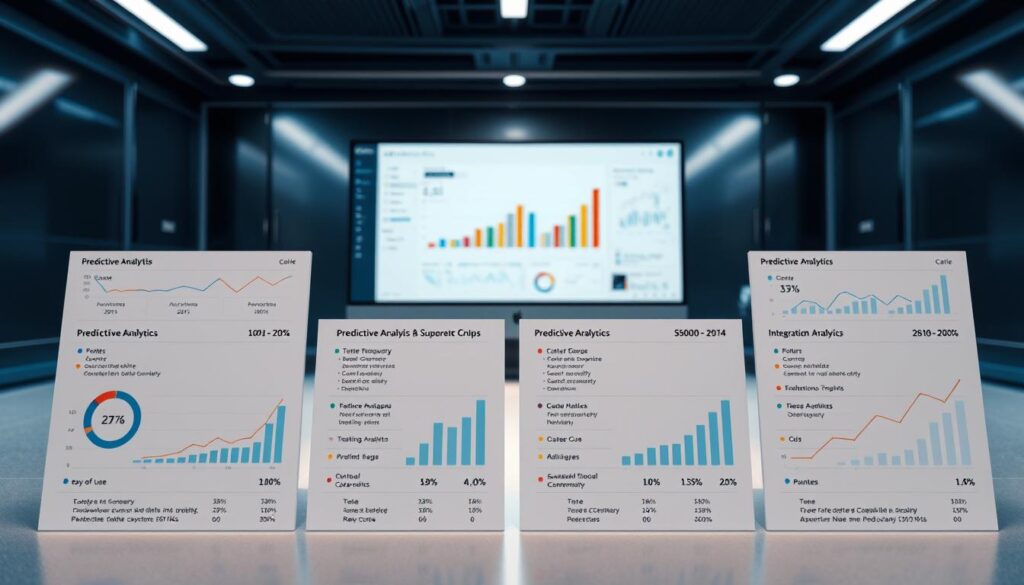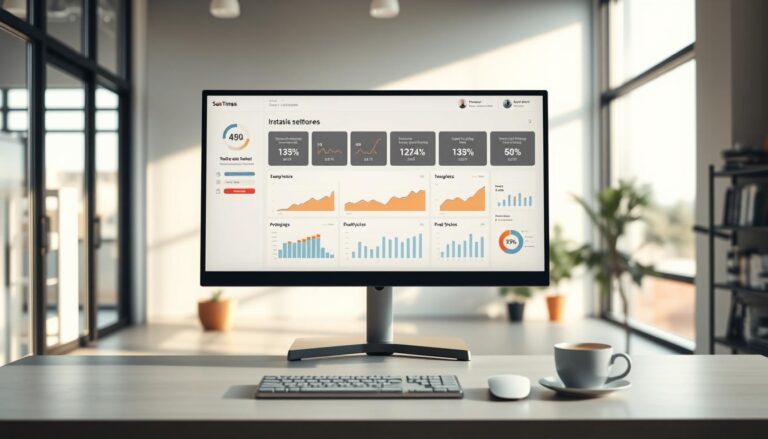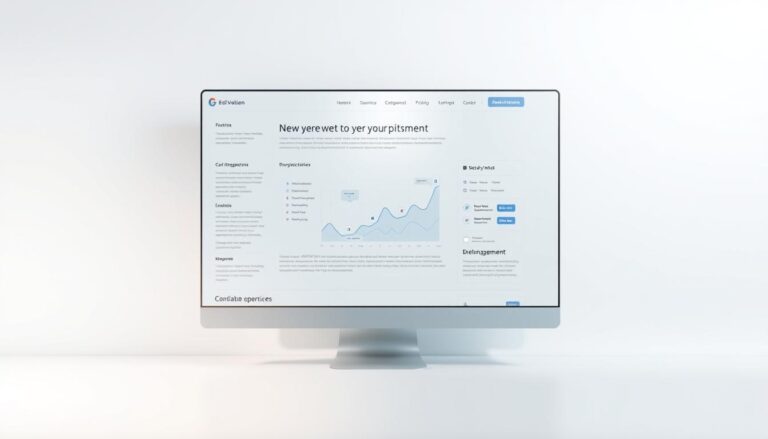Businesses today are quickly adopting technology to upgrade their sales game. clay.com’s predictive analytics platform stands out in this tech wave. With this sales prediction software, companies can predict customer desires, smooth out their workflows, and make choices based on solid data for growth. It offers deep insights into what customers like and do, helping teams improve their marketing and boost sales.
Teams using clay.com get to truly understand their customers. This means they can tweak their strategies to match what’s hot in the market, boosting how they connect with customers and their sales success. For those aiming to be the best in a fierce market, exploring this platform can make a big difference. For more on how tech is changing sales, see this piece on your virtual sales representative.
Key Takeaways
- Utilizing clay.com’s predictive analytics can enhance sales strategies.
- Understanding customer behavior is crucial for increasing engagement.
- Data-driven decisions improve forecast accuracy.
- Integration with existing tools helps streamline operations.
- Advanced analytics can significantly boost revenue generation.
- Staying ahead in sales means leveraging modern technology.
What is Predictive Analytics?
Predictive analytics uses statistics and machine learning to look at old data. It helps organizations foresee coming trends. It’s getting very important in many areas, especially in sales. Knowing about predictive modeling for sales gives insights. It shows how companies grow in today’s market that loves data.
Understanding Key Concepts
Predictive analytics has key parts like data mining, statistical modeling, and seeing patterns. Data mining finds hidden links in big data sets. Statistical modeling looks at how variables relate to each other. Seeing patterns helps make better decisions and plans. These parts are vital for using predictive analytics in sales. They help companies use their data well.
Benefits of Predictive Analytics in Sales
Adding predictive analytics to sales has many benefits. It makes decision-making better. It helps sales teams find the right customers. Using predictive modeling can make marketing work better and improve sales. Businesses can guess what customers want and offer it to them. This leads to an edge over competitors.
| Benefit | Description |
|---|---|
| Improved Decision-Making | Data-driven insights empower sales teams to make informed choices. |
| Enhanced Target Marketing | Predictive models help identify which customers are most likely to convert. |
| Increased Sales Conversion Rates | Tailored strategies lead to higher chances of closing deals. |
| Proactive Customer Engagement | Anticipating customer needs fosters stronger relationships and loyalty. |
The Role of clay.com in Sales Strategy
In the competitive world of sales, clay.com stands out as a powerful tool. It boosts productivity with its cutting-edge features. By using CRM predictive analytics, it makes processes smoother and helps achieve better results. Its integration with other tools is a breeze, making it easy for teams to start using it right away. This ensures a smooth workflow and efficient work.
Overview of clay.com Features
Clay.com is packed with features aimed at improving sales. It uses AI to make data more useful and improve how leads are managed. It also has tools for forecasting. These tools use past data to guess future market trends and customer needs. This lets sales teams focus on important tasks instead of getting stuck in admin work.
Integration with Existing Tools
One big plus of clay.com is how well it works with CRM systems. This means companies can add it to what they’re already doing without any problems. It works with many sales tools, making teamwork better. It also makes it quicker to use smart data in making daily choices.
Case Studies of Success
There are many success stories that show how great clay.com is. Different businesses have seen big improvements. For example, a software company saw a 30% rise in its closing rates and faster lead response times. This proves how powerful CRM and AI analytics can be when used well.
| Industry | Challenges Faced | Results After Clay.com Implementation |
|---|---|---|
| Software | Slow lead response time | 30% increase in closing rates |
| Retail | Poor customer segmentation | Improved targeting and personalization |
| Healthcare | Inefficient data management | Streamlined reporting processes |
How clay.com Enhances Customer Insights
Understanding customer behavior is essential for any sales team wanting to succeed. clay.com offers tools that help companies understand their customers better. This leads to strategies that meet customer needs and boost sales. With sales data analysis, businesses get a thorough view of their customers.
Analyzing Customer Behavior
With clay.com, it’s easy to look into customer behavior. The site uses smart algorithms to sort through data and show trends in what customers buy and like. This info helps businesses adjust their strategies to keep customers happy and coming back.
Segmenting Your Audience
Knowing how to group your audience is crucial for good marketing. clay.com lets companies divide their audience by things like age, interests, and buying behavior. This means marketing efforts can be more direct and effective. By using data analysis, companies find out which groups are most valuable and focus their efforts there.
Personalizing Marketing Efforts
Personalized marketing comes from understanding your customers. clay.com helps create marketing that talks directly to certain groups. Sales teams use this data to make messages that truly resonate. This approach improves engagement and conversions, making marketing more successful.
Key Features of clay.com’s Predictive Analytics
Clay.com brings several tools that improve predictive sales forecasting. These tools help businesses use data to make early decisions in a quick market. They include advanced data modeling, instant analytics, and automatic reporting, all aimed at improving sales.
Advanced Data Modeling
Advanced data modeling lets clay.com study past data to find unseen trends. This lets sales teams predict what customers will want and plan early. By using data well, companies can forecast sales better and beat their rivals.
Real-Time Analytics
Real-time analytics offer instant data on how well things are going, letting teams quickly adapt to market changes. They can see sales and customer changes right away, keeping sales plans up to date. Being quick to adjust is key in making better sales forecasts.
Automated Reporting Tools
Automated reporting makes it easier to keep an eye on important measures. With no need for manual reports, teams can focus more on making strategies from what they learn. This not only aids in smart decisions but also makes sales forecasts much more precise.
Benefits of Using clay.com for Sales Teams
Using clay.com helps sales teams greatly improve their work and results. It offers top-notch sales prediction and AI-driven sales analytics. This makes work smoother and boosts results. The platform takes over routine jobs and makes the sales process better. This lets teams focus on important interactions.
Increasing Sales Efficiency
Clay.com’s sales prediction software greatly increases efficiency. It cuts down hours spent on manual tasks. This change lets sales reps focus more on creating relationships and sealing deals. This boosts their work output significantly.
Improving Forecast Accuracy
Clay.com makes forecasts more accurate with AI-driven sales analytics. It uses huge data sets for precision. This leads to better sales strategies and operations. Teams can make choices based on solid data. This helps predict customer actions and meet market needs well.
Enhancing Decision-Making Processes
Clay.com also improves how decisions are made. It gives teams immediate access to insights and real-time data. This lets them quickly adjust their strategies for market changes. Access to detailed analytics makes decision-making quicker and more effective. You can learn more about these advantages here.
Getting Started with clay.com Predictive Analytics
Using clay.com predictive analytics for sales can change how you sell. By adopting a step-by-step approach, your team can use predictive analytics to get better results. This guide outlines key steps for integrating successfully and how clay.com helps you along the way.
Step-by-Step Implementation Guide
- Define Objectives: Decide on your main goals with predictive analytics, like boosting lead conversions or keeping customers longer.
- Data Integration: Mix your existing data with clay.com for accurate and reliable info.
- Feature Customization: Adjust the platform to fit your sales strategy, which makes insights more useful.
- Testing and Feedback: Test the system and get your sales team’s opinions to make necessary changes.
- Launch and Monitor: Start using the system and keep an eye on how it affects sales.
Training and Support Options
Clay.com knows learning is key to getting the most from predictive analytics in sales. They offer different training and support to help your team:
- Webinars: Online sessions happen regularly, giving deep knowledge on how to use the platform right.
- Documentation: You can find resources that explain the platform’s features, how things work, and tips for success.
- Customer Support: A team is always ready to help with any issues or questions you have.
- Community Forums: Talk with others using clay.com to share advice, insights, and strategies for best results.

These resources make sure your sales team can make the most of clay.com. They help drive success with better decisions and smart strategies.
Best Practices for Leveraging Predictive Analytics
Using advanced sales analytics can really change how a business faces market changes. To make the most of predictive analytics, firms need specific plans that match current market trends. Being proactive lets them make marketing moves that hit the mark with consumers and boost their success.
Tailoring Strategies to Market Trends
It’s key to keep up with how the market shifts. With advanced sales analytics, companies can collect immediate data. This lets them switch up their marketing to stay relevant. Good plans might involve:
- Monitoring competitors’ activities to see where they stand in the market.
- Analyzing customer feedback to make their products better.
- Adjusting pricing models according to what they predict will come.
Utilizing Predictive Insights for Upselling
Advanced analytics help find upselling chances that might not be obvious at first. Knowing what customers like and do, companies can offer more of what they want. Key strategies include:
- Identifying complementary products that customers might like.
- Offering targeted promotions looking at past buys.
- Training sales teams to spot upselling opportunities when talking to customers.
By adopting these methods, companies can get better at using predictive analytics. This leads to ongoing growth and deeper connections with their customers.
Measuring Success with clay.com’s Analytics
It’s key for any business to track how well their sales strategies are doing. With clay.com’s analytics tools, companies can check on important success markers (KPIs). This lets teams find useful things to do to make their plans better, using real data.
Some important KPIs are how many people are buying, how fast you respond to leads, and how people are interacting with campaigns. Understanding each of these helps businesses improve how they look at sales data to boost their performance.
Key Performance Indicators to Track
Focusing on the right KPIs lets businesses put their energy into what really counts. Here are some key indicators that tell you how you’re doing:
- Conversion Rates: Shows how good your sales process is at getting customers.
- Lead Response Times: Quick answers can make customers happier and increase sales.
- Campaign Engagement Metrics: These numbers tell you if your marketing is hitting the mark with your audience.
Analyzing Results and Adjusting Strategies
Using clay.com to look at these metrics helps sales teams make choices backed by data. They can see how they’re doing and change their sales plans as needed. This cycle of making things better, supported by math from the latest sales data techniques, helps with efficiency and meeting business goals.
| Performance Indicator | Description | Optimal Target |
|---|---|---|
| Conversion Rate | Percentage of leads turned into customers | 20% or higher |
| Lead Response Time | How fast you reply to a new lead | Under 5 minutes |
| Campaign Engagement | Tracks things like clicks and shares | 30% engagement rate |
Comparing clay.com to Other Predictive Analytics Tools
In the world of predictive analytics tools, choosing the right one is not easy. Clay.com stands out with features that are great for businesses using CRM predictive analytics. It connects smoothly with existing systems, unlike many others. Plus, its easy-to-use design simplifies complex data for any team member.
When looking at what clay.com offers differently, its strengths and weaknesses become clear. This helps you make an informed choice.
Unique Selling Points of clay.com
- Seamless Integration: clay.com connects easily with many tools, making setup smoother.
- User-Friendly Interface: Its intuitive design means anyone can use it without needing lots of training.
- Powerful AI Analytics: Its smart algorithms provide useful insights, improving CRM predictive analytics work.
Pros and Cons of Alternatives
| Platform | Pros | Cons |
|---|---|---|
| Platform A | High scalability | Complex interface |
| Platform B | Strong data visualization tools | Limited integration options |
| Platform C | Robust analytics | Steep learning curve |

Future Trends in Predictive Analytics for Sales
Looking ahead, the field of predictive analytics tools for sales is about to change a lot. This change is mainly because of new developments in artificial intelligence (AI) and machine learning. These technologies are improving analytics platforms and helping companies make smarter decisions. This progress helps sales teams predict customer actions better and match their strategies with new market trends.
The Impact of AI and Machine Learning
AI and machine learning are greatly changing sales analytics. They simplify analyzing complicated data and let organizations automate regular tasks. This means they can concentrate more on making big decisions. With advanced algorithms, analytics tools can now look at huge data sets in real time. This provides insights that weren’t possible before. These abilities let businesses improve their sales methods, use their resources better, and connect with customers more effectively.
Emerging Technologies and Their Implications
Other new technologies like blockchain and cloud computing are also shaping the future of sales analytics. Blockchain improves data security and trust, while cloud computing offers growth and flexibility. As these technologies become more common, companies will have to adjust to keep up. By adopting these new tools, businesses can make the most of predictive analytics. This will help them succeed in a world that relies more and more on data.
FAQ
What is predictive analytics?
Predictive analytics uses statistical techniques and machine learning. It examines past data to predict future trends, especially in sales.
How can clay.com improve my sales strategy?
clay.com provides advanced analytics and AI to help businesses. It helps understand customer behavior, predict outcomes, and improve sales strategies.
What features does clay.com provide for sales prediction?
clay.com offers features like advanced data modeling and real-time analytics. It also has automated reporting and integrates with CRM and sales tools.
How does clay.com help in understanding customer behavior?
clay.com helps sales teams by analyzing customer data. It aids in segmenting audiences and crafting personalized marketing to boost engagement and sales.
What are the benefits of using predictive analytics tools for sales?
Using predictive analytics tools leads to better decision-making and targeted marketing. It increases sales conversions and gives a competitive advantage by foreseeing customer needs.
How can I implement clay.com in my sales process?
To implement clay.com, integrate data, customize features, and train your team. These steps ensure effective use of clay.com’s predictive analytics in sales.
What KPIs should I track when using clay.com?
Track KPIs like conversion rates, lead response time, and campaign engagement. These metrics help evaluate the effectiveness of sales strategies using clay.com.
How does clay.com compare to other predictive analytics platforms?
Compared to others, clay.com offers better integration, a user-friendly interface, and powerful AI analytics. It improves efficiency significantly.
What future trends should I be aware of in predictive analytics?
Keep an eye on AI and machine learning advancements. They will automate sales further and enhance predictive capabilities, changing sales methods.
Can clay.com help with upselling opportunities?
Yes, clay.com identifies upselling opportunities using predictive insights. This helps businesses increase order values and build stronger customer connections with tailored suggestions.



